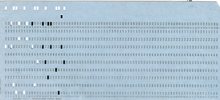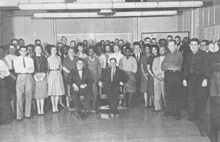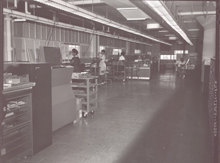The Creation of the National Oceanographic Data Center

Sample NODC punch card. Click image for larger view.
In an age where multiple megabytes of data and information will fit on something the size of a postage stamp, imagining that data storage was ever a problem may be difficult. If you know what a punch card is, you are probably either a history major, a Trivial Pursuit star, or you have worked in data management for more than a few years.
By the time the National Oceanographic Data Center (NODC) was created, a number of extensive, and expensive, oceanographic expeditions had been initiated or were underway. In fact, by 1931, the U.S. Navy Hydrographic Office had already determined data were coming in at such a rate that it was nearly impossible to keep up with the flow. Their solution to this problem involved a relatively new technology—data were keyed onto punch cards, and machines then tabulated the data. Imagine, boxes and boxes of punch cards, filled with data that would barely put a dent in the Palm Pilots of today…

NODC staff celebrates the Center’s 2nd anniversary in January, 1963. Harold Dubach, Deputy Director, and Dr. Woody Jacobs, Director, are seated in the center of the photo. Click image for larger view.
The new data center was officially established in the U.S. Navy Hydrographic Office as part of the Marine Sciences Division. The NODC opened its doors on November 1, 1960, with 29 employees ready to tackle the task of compiling, sorting, and stuffing the disparate collections of oceanographic data into a single system. Initial responsibility included unclassified physical, biological, and geophysical data. Standard formats were developed which required approval from the oceanographic community and had to be compatible with the computing capabilities of the Data Center.
The NODC grew rapidly. In just four years, the staff size increased to 114, including oceanographers, mathematicians, computer programmers, information specialists, and technicians, plus administrative and clerical support.

This photo, taken in Building 160 of the Washington Navy Yard, shows tabulation equipment operator machines that sorted and collated punch cards containing oceanographic data and then printed the data from the cards. Click image for larger view.
The Center was soon able to advertise that it offered the “world’s largest usable collection” of available oceanographic data and a variety of services, including extensive library searches. It was no longer a single Division within the Hydrographic Office, but a Department with four Divisions of its own, organized to receive and process the data (Operations Division); provide the data and data products back to the community (Services Division); develop systems and applications to process the data (Development Division); and do the computer processing, data entry, and systems operation (Computer Processing).
In 1970, the NODC was transferred by Executive Order to the newly formed National Oceanic and Atmospheric Administration (NOAA) under the Department of Commerce.
